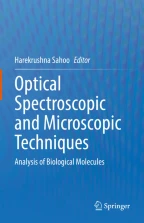Circular Dichroism Spectroscopy: Principle and Application

Circular dichroism spectroscopy is generally used to determine the secondary and tertiary structure of proteins. Its principle is based on differential absorption of left- and right-handed polarized light. To be detected by CD, the molecule should be asymmetrical; hence, the molecule should have one or more chiral chromophore. As optically active molecules absorb left- and right-handed circular polarized light differently, it becomes the basis of determining the biomolecule. There are different types of CD techniques depending upon the scanning spectrum range. Protein secondary structure is determined by UV CD technique. Similarly, vibrational CD and IR CD are used to study the structure of small organic molecules, proteins, and DNA, respectively.
This is a preview of subscription content, log in via an institution to check access.
Access this chapter
Subscribe and save
Springer+ Basic
€32.70 /Month
- Get 10 units per month
- Download Article/Chapter or eBook
- 1 Unit = 1 Article or 1 Chapter
- Cancel anytime
Buy Now
Price includes VAT (France)
eBook EUR 139.09 Price includes VAT (France)
Softcover Book EUR 179.34 Price includes VAT (France)
Hardcover Book EUR 179.34 Price includes VAT (France)
Tax calculation will be finalised at checkout
Purchases are for personal use only
Similar content being viewed by others

Electronic Circular Dichroism Spectroscopy in Structural Analysis of Biomolecular Systems
Chapter © 2014

Circular Dichroism (CD) Analyses of Protein-Protein Interactions
Chapter © 2015

Circular Dichroism of Peptides
Chapter © 2014
References
- Johnson WC (1996) Circular dichroism instrumentation, in circular dichroism and the conformational analysis of biomolecules. Springer, Berlin, pp 635–652 Google Scholar
- Corrêa DH, Ramos CH (2009) The use of circular dichroism spectroscopy to study protein folding, form and function. Afr J Biochem Res 3(5):164–173 Google Scholar
- Kelly SM, Jess TJ, Price NC (2005) How to study proteins by circular dichroism. Biochim Biophys Acta Prot Proteom 1751(2):119–139 CASGoogle Scholar
- Kelly SM, Price NC (2000) The use of circular dichroism in the investigation of protein structure and function. Curr Protein Pept Sci 1(4):349–384 CASPubMedGoogle Scholar
- de Jongh HH, de Kruijff B (1990) The conformational changes of apocytochrome c upon binding to phospholipid vesicles and micelles of phospholipid based detergents: a circular dichroism study. Biochim Biophys Acta Biomembr 1029(1):105–112 Google Scholar
- Keniry MA, Smith R (1979) Circular dichroic analysis of the secondary structure of myelin basic protein and derived peptides bound to detergents and to lipid vesicles. Biochim Biophys Acta Prot Struct 578(2):381–391 CASGoogle Scholar
- Chen YH, Yang JT, Martinez HM (1972) Determination of the secondary structures of proteins by circular dichroism and optical rotatory dispersion. Biochemistry 11(22):4120–4131 CASPubMedGoogle Scholar
- Chinnathambi S, Karthikeyen S, Kesherwani M, Velmurugan D, Hanagata N (2016) Underlying the mechanism of 5-fluorouracil and human serum albumin interaction: a biophysical study. J Phys Chem Biophys 6:214–222 Google Scholar
- Millan S, Satish L, Bera K, Konar M, Sahoo H (2018) Exploring the effect of 5-fluorouracil on conformation, stability and activity of lysozyme by combined approach of spectroscopic and theoretical studies. J Photochem Photobiol B Biol 179:23–31 CASGoogle Scholar
- Anand U, Jash C, Boddepalli RK, Shrivastava A, Mukherjee S (2011) Exploring the mechanism of fluorescence quenching in proteins induced by tetracycline. J Phys Chem B 115(19):6312–6320 CASPubMedGoogle Scholar
- Satish L, Sabera M, Sasidharan VV, Sahoo H (2018) Molecular level insight into the effect of triethyloctylammonium bromide on the structure, thermal stability, and activity of bovine serum albumin. Int J Biol Macromol 107:186–193 CASPubMedGoogle Scholar
- Anand U, Jash C, Mukherjee C (2011) Protein unfolding and subsequent refolding: a spectroscopic investigation. Phys Chem Chem Phys 13(45):20418–20426 CASPubMedGoogle Scholar
- De S, Girigoswami A (2006) A fluorimetric and circular dichroism study of hemoglobin—effect of pH and anionic amphiphiles. J Colloid Interface Sci 296(1):324–331 CASPubMedGoogle Scholar
- Taulier N, Chalikian TV (2001) Characterization of pH-induced transitions of β-lactoglobulin: ultrasonic, densimetric, and spectroscopic studies. J Mol Biol 314(4):873–889 CASPubMedGoogle Scholar
- Konar M, Sahoo JK, Sahoo H (2019) Impact of bone extracellular matrix mineral based nanoparticles on structure and stability of purified bone morphogenetic protein 2 (BMP-2). J Photochem Photobiol B Biol 198:111563–111570 CASGoogle Scholar
- Konar M, Sahoo H (2019) Phosphate and sulphate-mediated structure and stability of bone morphogenetic protein-2 (BMP-2): a spectroscopy enabled investigation. Int J Biol Macromol 135:1123–1133 CASPubMedGoogle Scholar
- Kypr J, Kejnovska I, Renciuk D, Vorlickova D (2009) Circular dichroism and conformational polymorphism of DNA. Nucleic Acids Res 37(6):1713–1725 CASPubMedPubMed CentralGoogle Scholar
- Miyahara T, Nakatsuji H, Sugiyama H (2016) Similarities and differences between RNA and DNA double-helical structures in circular dichroism spectroscopy: a SAC–CI study. J Phys Chem A 120(45):9008–9018 CASPubMedGoogle Scholar
- Gray DM, Ratliff RL, Vaughan MR (1992) Circular dichroism spectroscopy of DNA. Methods Enzymol 211:389–406 CASPubMedGoogle Scholar
Author information
- Suchismita Subadini, Pratyush Ranjan Hota and Devi Prasanna Behera have contributed equally to this work.
Authors and Affiliations
- Biophysical and Protein Chemistry Laboratory, Department of Chemistry, National Institute of Technology (NIT) Rourkela, Rourkela, Odisha, India Suchismita Subadini, Pratyush Ranjan Hota, Devi Prasanna Behera & Harekrushna Sahoo
- Center of Nanomaterials, National Institute of Technology (NIT) Rourkela, Rourkela, Odisha, India Harekrushna Sahoo
- Suchismita Subadini

